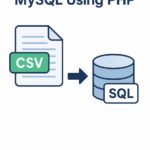<Files ".env">
Order allow,deny
Deny from all
</Files>Let’s break down, what it means, line by line:
In simple terms, this code blocks any web access to a file named .env. If someone tries to access https://www.it-india.net/.env in their browser, the server will deny the request and return a 403 Forbidden error.
Note: I thought about this article, while I was configuring .htaccess for my other website, trying to code a small search engine on IT-INDIA.net as a hobby.
Detailed Explanation
<Files ".env">- This is an opening directive that tells the server: “The following rules apply only to a file named exactly
.env.”
- This is an opening directive that tells the server: “The following rules apply only to a file named exactly
Order allow,deny- This defines the order in which the
allowanddenyrules are evaluated. In this case, it means “process anyallowrules first, then process thedenyrules.” The final result is determined by the last matching rule.
- This defines the order in which the
Deny from all- This is the rule itself. It means “deny access to this file from all clients,” regardless of their IP address. Since there are no
allowrules specified, and this is the last rule processed, the result is a blanket denial for everyone.
- This is the rule itself. It means “deny access to this file from all clients,” regardless of their IP address. Since there are no
</Files>- This closes the
<Files>block, indicating the end of the rules for the.envfile.
- This closes the
Why Is This Important?
The .env file is commonly used in web applications (especially PHP frameworks like Laravel) to store sensitive configuration settings as environment variables.
A typical .env file contains critical secrets like:
- Database usernames and passwords (
DB_USERNAME,DB_PASSWORD) - API keys for external services (e.g., Mailgun, Stripe, AWS)
- Application encryption keys (
APP_KEY) - Database hostnames and other configuration details
If this file were publicly accessible, it would be a massive security vulnerability, potentially giving an attacker complete access to your database and integrated services.
Modern Equivalent (Apache 2.4+)
The directives you posted (Order, Allow, Deny) are from the older Apache 2.2 syntax. The modern, recommended way to achieve the same result in Apache 2.4 and later is:
<Files ".env">
Require all denied
</Files>The Require all denied directive is simpler and more explicit, accomplishing the same goal of blocking all access. If your server runs a modern version of Apache, this is the preferred syntax.
In conclusion: This .htaccess snippet is a crucial security measure that prevents anyone from downloading a sensitive configuration file over the web.
Security Breaches and Stats:
It’s crucial to understand the cybersecurity landscape not just through technical rules, but through the real-world impact of breaches. Here are some key statistics that highlight the current state of security breaches.
These stats are sourced from reputable industry reports like IBM’s “Cost of a Data Breach”, Verizon’s “Data Breach Investigations Report” (DBIR), Ponemon Institute, and others.
Key Cybersecurity Breach Statistics
1. The Soaring Financial Cost
- Global Average Cost: The average total cost of a data breach reached $4.45 million in 2023 (IBM), an all-time high.
- Cost per Record: The average cost for every lost or stolen record containing sensitive information is $165 (IBM).
- Most Expensive Industry: Healthcare remains the industry with the highest average cost for a breach for the 13th year in a row, at $10.93 million per breach (IBM).
- Ransomware Costs: While the average ransomware attack cost $5.13 million (not including the ransom itself), the extortion payments can be massive. The average ransom payment in Q1 2023 was over $250,000 (CrowdStrike).
2. Primary Causes and Attack Vectors (The “How”)
- The Human Element: A staggering 74% of all breaches include a human element, such as stolen credentials, phishing, misuse, or simple errors (Verizon DBIR 2023).
- Credential Theft is King: Using stolen or compromised usernames and passwords is the most common initial attack vector, involved in nearly 50% of attacks.
- Phishing Persists: Phishing is a primary method for credential theft and malware deployment. Approximately 36% of all breaches involved a phishing attack (Verizon DBIR).
- Vulnerability Exploitation: The time it takes to exploit a known vulnerability is shrinking dramatically. Threat actors often weaponize new vulnerabilities within 15 days of a patch being released (CrowdStrike).
3. The Rise of Ransomware
- Ransomware is not slowing down. It was involved in 24% of all breaches (Verizon DBIR).
- A business falls victim to a ransomware attack every 14 seconds ( Cybersecurity Ventures).
- The “double extortion” model is now standard, where attackers not only encrypt data but also threaten to leak stolen data publicly if the ransom isn’t paid.
4. The Time to Detect and Contain (The “Why Speed Matters”)
- The Lifecycle of a Breach: On average, it takes an organization 204 days to identify a breach and 73 days to contain it (IBM). That’s over 9 months of undetected access.
- The Speed Advantage: Organizations that identify and contain a breach in under 200 days save over $1 million in costs compared to those that take longer (IBM).
5. The Impact of Security Practices
- AI & Automation Pays Off: Organizations with extensive use of AI and automation identified and contained a breach 108 days faster than those without. This also resulted in a massive cost saving of $1.76 million (IBM).
- The “Zero Trust” Advantage: Adopting a Zero Trust security model also significantly reduced costs. Organizations with a mature Zero Trust deployment saw an average breach cost of $4.15 million, compared to $5.27 million for those without it (IBM).
Key Takeaways and Advice for Your .htaccess Example
The .htaccess rule you showed is a perfect example of a proactive, defense-in-depth measure that directly addresses these statistics:
- Prevents Information Leakage: By blocking access to your
.envfile, you are directly protecting your credentials (database, API keys), which are the #1 target for attackers. This simple rule can prevent a catastrophic breach. - Reduces Attack Surface: It’s a specific rule that closes a common hole. Every exposed file is a potential entry point.
- It’s Basic Hygiene: This is the cybersecurity equivalent of locking your front door. It doesn’t stop a determined attacker who finds another way in, but it stops all the automated bots that are constantly scanning the internet for exactly this kind of exposed sensitive file.
In summary: The threat landscape is severe and expensive. Attacks are often automated and target low-hanging fruit. Implementing simple, effective security measures—like properly configuring your .htaccess file—is one of the most important and cost-effective things you can do to protect your systems and data.
✍️ Need Content Like This?
We craft high-quality, SEO-optimized articles tailored for blogs, news sites, and educational platforms. If you enjoy thoughtful writing and open-source spirit, just buy me a coffee and I’ll write 1,000 words for you. Let’s build something meaningful together. Contact us to get started.

